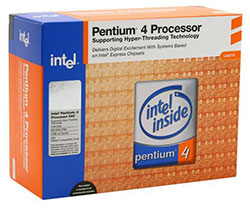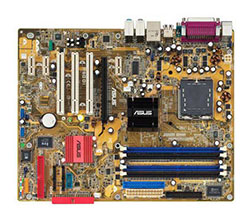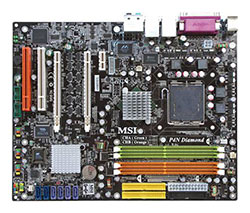Buyer's Guide: Mid-Range to High-End, May 2005
by Jarred Walton on May 23, 2005 5:30 PM EST- Posted in
- Guides
Intel Recommendations
Intel Processors
There are always people who continue to prefer Intel processors for whatever reason. We feel that AMD has the upper hand right now - both in price as well as performance - but there are merits to the Intel platform. We've said it many times before, but let us reiterate that anyone interested in serious 3D gaming should just forget the Intel chips for now. It's really that cut and dry, unfortunately. The dual core Pentium D 8xx parts should also show up at retail any time now, and since multitasking is probably the best argument for Intel enthusiasts, we would seriously recommend waiting for those chips. Those looking to purchase an Intel system now still need to make the decision between 5xx with higher clock speeds and 6xx with more features. (The 5xx chips with EM64T are not yet available either.) In the end, we still can't offer a "one size fits all" choice, so we're declaring it a draw between the two processor lines. You can get a similarly priced 5xx or 6xx chip for both price points, but we're going with 5xx for the Mid-Range and 6xx for the High-End.Intel Mid-Range Recommendation
Processor: Pentium 540J 3.2GHz 1MB (Retail) - Prescott core
Price: $213 Shipped
It's telling that the most reasonably priced CPU from Intel continues to be their 3.2 GHz part. Wasn't the 3.2C originally launched almost two years ago? Anyway, faster Pentium chips are available, but the price scales rapidly. You could even opt for the 3.0 GHz 530J and still get reasonable performance - particularly with overclocking. Although, make sure that you get an appropriate motherboard if you plan on overclocking with an Intel chipset! The 6xx series counterpart to the 540J is the 630, which comes clocked at 3.0 GHz, costs $15 more, and comes with 64-bit support and more cache. If you want to overclock, we'd suggest forgetting 64-bit support and sticking with the 5xx series - doubling the L2 cache does not help with overclocking, needless to say. Still, feel free to try your luck.
Intel High-End Recommendation
Processor: Pentium 650 3.4GHz 2MB (Retail) - Irwindale/Prescott 2M core
Price: $412 Shipped
With the High-End Intel setup, we feel that it only makes sense to grab a 64-bit capable processor. Not everyone is going to need the ability to run XP-64, but if you're going to spend over $400 on a CPU, we think that you're more likely to be part of the bleeding edge who likes to try all the latest and greatest hardware and software. If you disagree or still feel that clock speed is king, the Pentium 560J runs at 3.6 GHz and omits support for EM64T, all while costing $7 (wow!) less. (The 561 should arrive some time in the next couple of months if you're interested in 64-bit support without the 2MB cache.)
The difference between the Mid-Range and High-End Intel processors ends up being just 400 MHz - only 12% to 13% faster in terms of clock speed. Of course, you could also take the CPU recommendation up one more step to the 570J or 660, which would add another $200. (We don't think that it's worth it either.) It's interesting to note that we've had reasonable success running most recent Prescott "J" chips with a 14X multiplier and 1066FSB. All new Pentium 4 processors support EIST, which allows them to reduce the CPU speed and voltages and drop down to 2.8 GHz on an appropriate motherboard. Most enthusiast motherboards allow you to lock the multiplier at 14X and run with the faster bus speed. 3.73GHz ends up outperforming everything including the 570J (due to the increased bus speeds and memory bandwidth, although it's basically a tie) while costing hundreds of dollars less, but nothing is guaranteed with overclocking and some people prefer the guaranteed performance at stock speeds.
Intel Motherboards
The best motherboards for Intel processors pretty much always use Intel chipsets. That may change with the new NVIDIA nForce 4 SLI chipset, but motherboards using the NVIDIA chipset are difficult to find at retail. Furthermore, the new dual core Pentium D processors will require a new chipset to work. That means Intel's 945 and 955 chipsets or the aforementioned nForce 4 SLI for 775. We're still waiting for widespread retail availability (as well as a price drop), which should hopefully come during the next couple of weeks. Newegg and ZipZoomFly (and a few others) have the ASUS P5WD2 (955X) and the MSI P4N Diamond (nF4 SLI), but both cost nearly $250 right now and you still can't find dual core processors. All these factors combined make it difficult to recommend any current socket 775 motherboard, but it's not impossible. There are many good motherboards for both platforms, so just because we don't specifically mention a motherboard, it doesn't mean it's a poor choice. Rather than trying to list the pros and cons of dozens of motherboards, we would suggest that you visit our forums if you want further advice. (Or you can always try emailing us.)Intel Mid-Range Recommendation
Motherboard: ASUS P5GD1
Price: $110 Shipped
There are several things that we're looking for in a decent socket 775 motherboard for a Mid-Range PC. First, we want HD audio and GbE - preferably on the PCIe bus for GbE. We've talked about the difference in price between DDR and DDR2 in the past, but now prices have dropped to the point where that isn't as big of a concern; what's important now is that the board needs to have four memory slots of the same type, since you can't use DDR and DDR2 at the same time. We've never been fans of combo memory designs, as they usually involve a compromise, and that's the case here. Additional features are welcome, but not required, and in the end, we're back to the same ASUS motherboard from our last Mid-Range Guide, albeit with a reduced price. The P5GD1 meets all of the above, and adds in more PATA connectors, good overclocking support, ASUS' proven reliability, and it's still one of the cheaper 775 boards.
The usual suspects are all there with competing products, but they all cost more without offering a whole lot in the way of improved features. The EPoX EP-5EPA+ did well in our roundup, but it's still just a similar product to the ASUS at a higher price. The same goes for the Abit GD8, while the AG8 adds Firewire ports (the only real omission on the ASUS board). The only board that offers something really different from the ASUS is the MSI 915P Neo2 Platinum. It supports DDR2 memory and also has a Firewire connection. Why would you want DDR2 memory? We'll cover this more in the RAM section, but the short answer is that the price/performance for overclocking setups is pretty good.
Intel High-End Recommendation
Motherboard: MSI P4N Diamond
Price: $229 Shipped
Our High-End board is one of the most expensive motherboards that we've ever recommended, and we're giving this recommendation with quite a few caveats. First, we assume that dual core support will work properly (we haven't officially tested it). The bigger factor is that it's one of the few current Intel platform motherboards to support SLI, so if you want Intel and you want the most powerful gaming configuration possible, then you want an nForce 4 SLI board. If you can find a Pentium D to go with this board, our misgivings are not as severe, as certain multitasking tests show that Intel can still beat AMD in that area - particularly when you consider that Pentium D should be available before and cost significantly less than Athlon X2. Just remember that you're spending $70 extra on the motherboard, which certainly cuts into the cost benefits of the platform.
If you want SLI and you don't want to wait for Pentium D to show up at retail, then you're better off with the AMD platform. If you still insist on Intel, that's your right, but most people would say that you're being stubborn. Then again, the cost of a Pentium 4 540J (3.2 GHz) now and a Pentium D 830 (3.0 GHz) later would still be less than the current suggested cost of the cheapest Athlon 64 X2. (My, how the times have changed.) Coupled with the current release schedule - Pentium D should appear at retail several months before Athlon X2 - the High-End, early adopter who demands multitasking performance will probably want to give Intel options some thought. You could always look to SMP workstation setups as well, but then you lose SLI, and that's not something that we want to do for our High-End recommendation.
We should also mention the other SLI option for Intel, the ASUS P5ND2-SLI Deluxe. We've tested that board (along with the P5WD2) and it certainly offers a lot of features. The reason why we didn't recommend it over the MSI board is that it costs an extra $50. Perhaps the MSI board will support DDR2 RAM running at DDR2-1000 speeds and perhaps not. However, most of us don't feel that the additional percentage points gained in performance are worth the increased cost. For gamers, full SLI support is far more important than increased memory speed support.














60 Comments
View All Comments
ProviaFan - Monday, May 23, 2005 - link
And I had an Epox board (8RDA, which was all the rage when it came out) die just over a year old from bad capacitors. Now, I use an Abit NF7-S v2, but found the guide useful as I'm planning an upgrade "soon" (dual core is necessary as I'm a non-gaming multitasker: Photoshop, Illustrator, Indesign - at the same time, and SMP is well beyond the budget).Thanks Jarred, I appreciated the article, despite the few typos and the whiner(s) in the comment section. :)
arswihart - Monday, May 23, 2005 - link
I think Epox is more than a step above Biostar and Soltek, as for customer support, Epox is lightyears better than Asus and MSI, so not sure what you are referring to there. They also have the best BIOS support I've ever seen, always updated quickly and often, so again I don't know where you are getting your information.kevindarcy - Monday, May 23, 2005 - link
For those of us who run our PCs continuously, I think Anandtech should be giving a clear recommendation of Venice over Newcastle, regardless of their respective overclocking potentials, or support of SSE3. According to PC Perspective (http://www.pcper.com/article.php?aid=127&type=... a Venice CPU consumes 20W less than an equivalent Newcastle at idle, and 37W less under load (!). Where I live, the electricity savings alone, based on the "idle" number, are at least $16/yr, more than enough to justify the (hopefully temporary) price differential, not to mention the "intangible" benefits of having a quieter, cooler-running computer.JarredWalton - Monday, May 23, 2005 - link
15 - typo. Fixed now.1 - Would you buy a LAN card for a PC? Most people would say no, and I feel about the same for audio. If you find the integrated audio is lacking, it's simple enough to add a sound card after the fact.
whatever - Monday, May 23, 2005 - link
quote:That means Intel's 845 and 855 chipsets or the aforementioned nForce 4 SLI for 775.
Isn't 845 and 855 old? don't they mean 945 and 955? (this is from the Intel mobos section)
KristopherKubicki - Monday, May 23, 2005 - link
>and I even wonder sometimes if your site is getting some compensation for these recommendations.arswihart: Generally we will always recommend at Tier 1 motherboard manufacturer over a Tier 2 one. The peripheral things like product support, updates and MTBF usually sway our opinion in favor of an ASUS/MSI/Gigabyte board over a Biostar/Epox/Soltek board even if they are nearly the same. By the way, Epox's production was actually via another Tier 1 production house until not too long ago.
Kristopher
JarredWalton - Monday, May 23, 2005 - link
*I'm* not in the market for an SLI rig. Very few people really are. My 6800GT is more than powerful enough for what I do, and I think most people feel the same way.The reason I went with SLI for the High-End is because I feel people that are interested in spending $500+ on a CPU are probably going to be interested in the bragging rights of SLI. I think the Mid-Range is the sweet spot for computer purchases, so I really look at the High-End market as potential upgrades rather than entire systems. Of course, if you win the lottery or something, go for it! :)
arswihart - Monday, May 23, 2005 - link
i only say that because the products I refer to have been available for many many months, except for the 9npa sli. It is nonsense that you haven't been aware of their existence until today.arswihart - Monday, May 23, 2005 - link
you mean you miss all of them, not just some of themJarredWalton - Monday, May 23, 2005 - link
I've been going by the AnandTech Pricing Engine (which is apparently missing the EPoX and Biostar SLI products). I generally search around at Newegg, ZipZoomFly, ChiefValue, Monarch, and several other sites to verify that I've got the best prices I can find as well as most recent product lists, but obviously I miss some of them. Sorry.As for the EPoX nF4 Ultra vs. Chaintech, I wouldn't say the EPoX board is bad (though I haven't tested it), but past experience is that it's probably not much better than other options. We'll be coming out with a new nF4 motherboard roundup, so I'll have to see what our other editors say about the various models. :)
(I did mention nF3, by the way - at the top of the page. I would't recommend it for a complete new system, but for upgraders it's still a reasonable choice.)